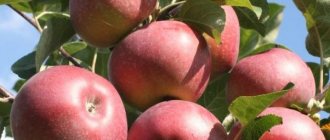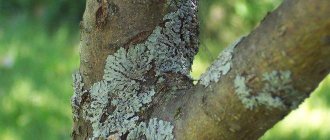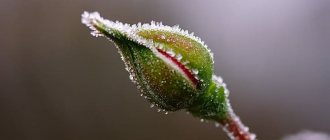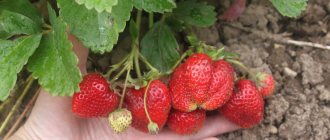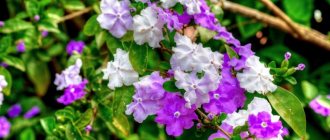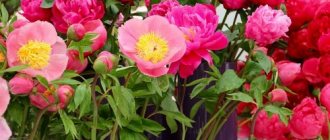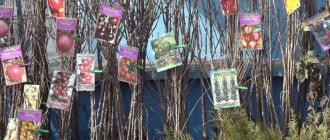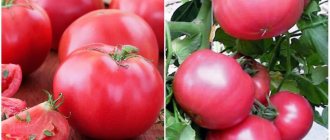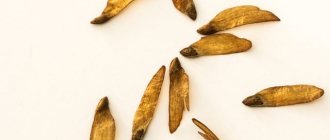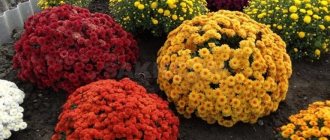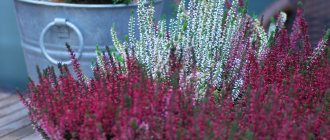What gardening tools are needed to care for an apple tree?
The main care of an apple tree consists of pruning. It is carried out using:
- pruning shears;
- loppers with long handles;
- garden saw.
A well-kept garden bears fruit every year
Plastic scrapers and hard brushes are used to clean dead bark. Whitewashing is applied to trees with a brush or spray gun.
You need to purchase a garden sprayer (a backpack one is convenient) with a long retractable handle. It will be needed for treating the crown from pests and diseases, and for foliar feeding. When the trees enter the fruiting period, a fruit picker will come in handy to collect apples from the upper branches.
Features of modern hybrids and clones
Not all gardeners can plant a vigorous garden due to the small size of the plot. Then modern selection comes to the rescue. Experts have created many varieties of fruit trees that take up little space.
Among them are representatives of the following groups:
| Columnar | Trees 2–2.5 m high with a greatly shortened crown. Flowers and fruits are on short petioles and are actually located on the trunk. They are distinguished by high precociousness. |
| Dwarf | They have the exact same shape as vigorous apple trees, but do not grow more than three meters. Limitation in growth is determined by grafting onto special clonal rootstocks, which limit the size of the adult plant. |
| Semi-dwarf | They differ from dwarf varieties in size; their maximum height is 3 - 4 m. |
| Standard | They are created not only for the harvest, but also for the decorative effect of the crown, which is evenly formed around the trunk (trunk) for beauty. |
| Trellis | A method of forming an apple tree by attaching branches to a horizontally stretched trellis. As a result, fruit plantings are formed, similar to vertical gardening. |
How to properly plant columnar apple trees “Moscow Necklace”, “Currency”, “President”
In 1964, Canadian breeders discovered a spontaneous mutation on the Mackintosh apple tree. There were no characteristic branches on the shoot, and the fruits were located on short internodes, close to each other. This feature formed the basis for hybridization, as a result of which the columnar group appeared.
Although the crown of the clones is narrow and compact, the root system is powerful, so the planting pit is prepared in the same way as for vigorous varieties
The difference is the distance between the trees. Columnar plants are planted at intervals of 70–80 cm.
Columnar varieties are often placed along the fence. If the fence is solid and lightproof, then it is better to choose the western side. In the morning, the row is in the shade for a short time, and in the afternoon it will be illuminated for a long time, which has a beneficial effect on the size and taste of the apples.
The trees are positioned so that they do not touch each other or the fence. Each apple tree needs access from all sides for easy care.
The distance in the row between columnar apple trees is 50 – 70 cm
Columnar apple trees are planted in the same way as vigorous varieties, preparing in advance a planting hole filled with fertile soil of neutral reaction . Most hybrids in this group are sold with a clod of soil. This means that planting can be done at any time of the year.
The plant feels almost no stress when placed in a new location. Recently, it is often practiced to plant a flowering tree in the spring, and in the summer, actually harvest the first harvest.
Pruning columnar apple trees is radically different from forming the crown of vigorous varieties. You can't cut off the top! If the growth point is damaged, the side shoots begin to branch and the column turns into an ordinary tree.
Among owners of small plots, “Moscow Necklace”, the original name of the variety “X - 2” , is popular; it is also used on sale, like the second option.
Apple Columnar "Moscow Necklace"
Gardeners fell in love with the variety for its almost 100% survival rate and ease of care. Planting pattern: 50–70 cm between trees in a row and 1.2 m between rows. The rows are directed from south to north. With the exception of pruning, care for columnar apple trees is carried out in the same way as for vigorous winter varieties.
The harvest is harvested in October. In the first year they receive several pieces - 5 -6. An adult tree can produce 4–7 kg.
The disadvantage of columnar apple trees is their relatively short life span - 15 - 20 years.
Another popular representative of apple trees with a compact crown is the winter hybrid "Currency" . Famous for its long shelf life. When ripening in October, apples remain fresh and juicy until March and April.
Hybrid variety "Currency"
- The variety is planted both as seedlings and with a clod.
- Young plants with bare roots are transferred to open ground in April, May, and autumn after leaf fall, but no later than 2 weeks before the onset of stable frosts.
- The average height of the tree is 2 m, with a crown diameter of 20 cm.
- The first harvest ripens in the fifth year.
- The maximum number of apples from one mature tree is 6 kg.
An important advantage of the variety is its high resistance to a dangerous disease - scab . It also resists many pests well.
"Currency", as a typical columnar representative, has a superficial root system.
Thin hair-like roots are located close to the surface of the earth and are prone to drying out. To avoid frequent watering, tree trunk circles or row strips are covered with a thick layer of mulch to prevent evaporation.
For protection and as MRL (slow-acting fertilizer) use:
- Dried grass
- Straw
- wood chips
- fine bark
The material is evenly distributed around the trees, in a layer of 7–10 cm. From time to time, the mulch needs to be checked so that it does not rot due to overcompaction. Many gardeners successfully use EM preparations. Organic farming products activate the growth of beneficial microflora that synthesize humus in the soil.
This type of care creates a triple benefit . Mulch retains moisture and protects against weeds, EM preparations provide nutrition to the apple tree. The variety needs shelter for the winter in the first years of its life. An adult tree is highly frost-resistant and does not need protection from the cold.
The world-famous “President” was obtained by domestic specialists by crossing the varieties “Vazhak” and “Obilnoe”. Belongs to autumn varieties. The fruits are stored until the New Year.
Botanical features:
- The powerful trunk grows up to two meters.
- The crown width does not exceed 25 cm.
- Fruitlets and ringlets are densely located along the trunk.
The columnar hybrid is unpretentious to the soil and grows well on sandy loam soil and medium loam. The best yield is achieved on rich, light loams. Care is typical for representatives of this category of apple trees.
Where to place dwarf hybrids “Welsea” and “Melba” on the site and how to care for them
Dwarf apple trees are often called new species. This is wrong! Low-growing hybrids are obtained by grafting the desired variety onto a small clonal rootstock, which are divided into dwarf and semi-dwarf. Low-growing varieties of apple trees, especially used as rootstocks, are called dusens.
Apple tree "Welsea"
Type III is the most common; dwarf varieties are grafted onto it, the height of which does not exceed 4 m . The crown exactly resembles a vigorous apple tree, but its diameter is on average 3 m.
Dwarf varieties are grafted onto miniature rootstocks - paradise.
Trees propagated by budding on low-growing apple trees have a shallow root system that is prone to wind damage . Therefore, when growing, they are attached to a powerful support, which accompanies them throughout their lives.
Another drawback is low frost resistance, due to which dwarf varieties are grown in the southern regions. But, there are exceptions for colder climate zones, for example, the hybrid of American origin "Welsea". It is popular due to its high yield - up to 200 kg per tree, and long-term preservation of the fruit. The fruits are harvested at the end of September and eaten from October to February.
Dwarf apple trees grow up to 3 – 4 m in diameter
For semi-dwarf varieties, resistance to low temperatures is relatively high, up to minus 25 C. According to the international USDA gradation, it belongs to the fifth climatic zone.
Planting is no different from the methods for vigorous varieties. But care requires specific attention. The structure of the crown differs from the shape of a typical apple tree. The branches of "Welsie" grow at an acute angle to the trunk and are directed upward.
Without intervention, a wide pyramidal crown is formed. Therefore, from the first years of life, while the shoots are flexible, they are bent and fixed with pegs and a cord in a horizontal position.
Using this method, the branches are wrapped with soft cloth where the twine is attached so as not to damage the bark. When the shoots take the desired position and become woody, the winding and cord are replaced with others. The lower tier of skeletal branches is fixed, not only to maintain shape, but to avoid creases from the wind.
Another feature is the tendency to excessive fruiting, which has to be regulated. Otherwise, the fruits will be small and sour. The branches break from the excess harvest. To prevent overload, the excess ovary is removed.
obtained as a result of open pollination of the Canadian variety "Meckintosh", deserves special attention Belongs to the autumn group, ripens in late August, early September. Apples are well preserved until March next year.
The variety is resistant to scab, but does not tolerate severe frosts.
An open, sunny place, well protected from strong winds and seasonal drafts, is suitable for planting. The variety requires strong support throughout its life. Due to their shallow root system, mature trees are susceptible to wind damage.
A planting hole is prepared for the seedlings, as for vigorous apple trees, with a diameter of 1 m and 70 cm in depth . If there are several trees, then the distance between them in a row is 3 - 4 m, in the row spacing - 5 m. The shape of the crown is rounded at the bottom and elongated at the top. Pruning and branch formation are not as intense as, for example, the Welsh variety.
Further care:
- Systematic watering - weekly in spring, from mid-summer - once every 10 - 15 days, moisture-charging watering in autumn - 70 - 80 liters.
- It is preferable to fertilize with organic fertilizers - leaf humus or rotted manure.
- In spring, spray with protective agents before flowering and immediately after it. Autumn treatment is carried out after leaf fall.
When choosing dwarf varieties, it is worth comparing the positive and negative properties of apple trees of this type.
A typical representative of semi-dwarfs is “Ural Bulk”
The middle niche between the dwarf and vigorous group is occupied by a variety measuring 4 – 5 m in height and 3 – 4 m in the crown . One of the favorites in the semi-dwarf Ural Liquid category. The variety was bred by crossing “Papirovka” and “Red Ranetka”. The shape and color of the apples exactly repeat the “Papirovka”.
Fruits of the Uralskaya nalivnaya apple tree
It begins to grow in the spring and blooms earlier than other apple trees. In this connection, autumn planting in pre-filled holes is recommended.
It lends itself well to grafting from cuttings.
- When caring, not only pruning is used, but also bending back of young branches. What is even more important is to prevent creases during a bountiful harvest.
- Valued for its high frost resistance; cases of successful wintering at minus 570 have been recorded.
- Generous fruiting amounts to more than 100 kg from one mature tree.
- The average productive age is 30 years or more with proper care.
What are standard apple trees, and how do they differ from traditional varieties?
The part of the trunk from the root collar to the first skeletal branch is called the trunk . Often the crown is formed more for beauty than for harvest. At the same time, branches are removed to the desired height or kerbovka is carried out, stimulating the growth of dormant buds.
Standard apple trees are formed for decoration and convenience
The method is used to obtain decorative forms, for example, weeping . To do this, the trunk is grown to the required height, the skeletal branches are cut short and cuttings are grafted onto them, directing them to the bottom. The method is more often used in ornamental gardening, but recently it has been successfully used on low-growing varieties of apple trees.
The result is a spectacular crown that looks unusual at any time of the year. When caring, you need to ensure that straight shoots of the rootstock do not grow. They are removed if shoots appear below the grafting site.
Features of caring for seedlings in the first year of planting
Caring for apple tree seedlings consists of regular watering, not as abundant as that of adult trees, but more frequent. The root system of the tree has not yet penetrated deep into the soil and cannot fully absorb moisture. A young garden should be watered at least 2 times a month in summer.
Propagation of forsythia by cuttings - how to propagate in summer
If the planting hole was filled with highly nutritious soil, then the tree does not need feeding in the first year. Otherwise, it is necessary to apply nitrogen fertilizer (urea solution, ammonium nitrate or manure infusion) 3 weeks after planting. At the end of summer, seedlings should be watered with a solution of superphosphate and potassium salt.
Important! In regions with harsh winters, it is recommended to insulate the trunk of seedlings with agricultural fabric or straw. Mulch the tree trunk circle with sawdust, peat, and leaves.
September October
- In the fall, carry out the last fertilizing of the season - in mid-September, add 1 tbsp. l. potassium sulfate per 1 m² of trunk circle for adult plants and 0.5 tbsp. l. under the young.
- At the end of October, carry out moisture-recharging watering - pour 10 buckets of water under each apple tree and mulch the tree trunk circle with humus.
- Collect fall and winter apple varieties and store them.
- You can still have time to plant apple tree seedlings - all types of planting work are the same as in the spring.
Photo: apple trees on a trunk
Spring care principles
How to propagate garden jasmine in spring and summer
At this time of year, it is important to help the tree emerge from hibernation without loss:
- Remove the cover, if there was one, remove the old mulch and burn it. This should be done when the daytime temperature rises to +10 degrees.
- Clean the crown. Whitewash the trunk and skeletal branches with lime mixed with PVA glue (this way the whitewash lasts longer).
- Feed the garden with nitrogen fertilizers.
Whitewashing protects wood from sunburn and pests
Important! Knowing everything about the biology of the apple tree, you can have a harvest even in an unfavorable year.
How to protect an apple tree from return frosts
In the Moscow region and other regions with a similar climate, blossoming apple trees are often threatened by frost. If the air temperature during the flowering period drops to -2 degrees, the fruits will not set.
How to properly care for a blossoming apple tree if frost is expected:
- The crown of the tree should be watered generously with water from a hose every 3-4 hours. Water, freezing on the flowers, will prevent frost from destroying the reproductive organs of the plant.
- The day before and immediately after freezing, trees should be sprayed with Epin solution. A biological stimulant helps the plant cope with stress and increases resistance to cold.
- In the garden between the trees, light fires from grass or rotted hay. The smoke screen that envelops the garden will become a barrier to the cold.
Corrective pruning of apple trees in spring
In spring, mature trees need sanitary pruning. Broken, frost-damaged branches must be removed.
When caring for young apple trees in spring and summer, there is also corrective pruning aimed at building the correct crown. For a fruit tree, a cup-shaped shape is convenient, when the central conductor is shortened and the side branches form a circle. For apple trees, a tiered crown in the shape of a pyramid is popular. Which type of pruning to choose is up to the dacha owner to decide.
Important! Cuts on the tree should be treated with garden varnish or clay mash.
Proper tree formation is the key to abundant fruiting
Description of the apple tree
The apple tree is the most common tree in Russian gardens. This culture has taken root in Russian gardens a long time ago. The apple tree belongs to the Rosaceae family; in nature there are up to 50 species of this plant. These can be either trees up to 12–15 meters tall, or low shrubs.
Three types of this plant are domesticated: Chinese, plum-leaved and the most common - home apple , which has many varietal forms.
The domestic apple tree enjoys temperate climates and does not grow well in areas with warmer weather conditions. The lifespan of an apple tree is on average 30–35 years; it bears maximum fruit within 15–30 years; of course, we are talking about an ordinary tree, and not about dwarf forms, since these plants live shorter and their fruiting period is shorter.
Different varieties have different taste qualities and aroma of the fruit, so in order to fully obtain the full spectrum of taste and nutrients, experienced gardeners grow several varieties of apple trees that bear fruit from late June until late autumn.
To get a good harvest, you need to follow the rules for planting and growing apple trees, take good care of the plants: feed them, shape the crown of the tree, identify diseases and pests in time and take measures to combat them.
Features of summer care
Caring for an apple tree in summer is simple and easy. Even a child can handle watering trees on a hot day. It is enough to throw the hose into the tree-trunk circle, where pre-drilled holes are 30-40 cm deep.
Caring for roses in the summer at the dacha in the open ground
Garden feeding schedule:
- In June, after flowering, trees should be sprayed with a composition containing microelements (magnesium, boron, zinc). The drugs “MagBor”, “Plodovit”, “Alliance” are used. It is useful to treat the foliage with a urea solution (1 tablespoon per bucket of water).
- In July, the ovary actively grows, so the tree needs a balanced diet. Irrigation with a solution of complex mineral fertilizer (“Gera”, “Fertika”) is used.
How to care for a young apple tree that does not bear fruit:
- water regularly, keeping the soil moderately moist;
- spray for pests.
On a note! Even a healthy tree sheds excess ovary in the summer. This is normal and is not considered a sign of illness.
Fertilizers and fertilizers
Fertilizers allow the apple tree to accumulate a large vegetative mass, which in the future will allow it to grow many tasty fruits. To do this, in the first 2 years, fertilizing is done in early spring.
The first fertilizing is done with mullein infusion, and in May and June one foliar fertilizing is done with a complex fertilizer with microelements (“Zdraven-Turbo”, “Agrovita for fruit trees”, “Alliance for fruit trees”).
Watch the video about cow manure fertilizer:
To root-feed apple trees with nitrogen in the spring, you need to pour a bucket of compost or humus into the tree trunk circle and level it.
In the following years, before the apple trees begin to bear fruit, in addition to spring fertilizing with humus with simultaneous mulching of the trunk circle (12-18 kg per tree), in the fall they fertilize with phosphorus-potassium mineral salts, for digging or hoeing:
- For southern gardens - potassium sulfate 25-35g, double superphosphate 25-35g; ashes from a fire or wood ash 150 grams;
- For non-chernozem regions - double superphosphate 35-45g, potassium sulfate 35-50 grams, ash or ash 250 grams.
TIP: Do not overfeed trees with fertilizers, especially nitrogen. This has a bad effect on the overwintering of apple trees and the keeping quality of apples. It would be better to supplement the feeding of the subcortex “by leaf” with complex fertilizer (as indicated above) or the missing element.
It is also customary to feed apple trees that have just begun to bear fruit with urea, and in years with poor flowering this can be done later.
To do this, dissolve 35 grams of urea in 10 liters of water and treat the tree with a sprayer.
The first treatment is as soon as the flower petals of the apple trees fall off, the second is a month later, and the third is when the fruits are filling. The last time the dose can be increased to 55 grams if the weather is cool and the summer is damp.
Loosening the soil in the tree trunk circle
To enrich the soil with oxygen, it is useful to carry out shallow loosening of the soil. It is enough to immerse the rake by 5-7 cm, no more.
Mulching and sodding
More and more gardeners are practicing “natural” cultivation of apple trees, when there is no bare soil in the garden. The space under the trees is sown with grasses (clover, phacelia, alfalfa, bluegrass, bentgrass) or covered with straw or mown hay.
Worms actively reproduce under the mulch and loosen the soil. The roots of the tree are well protected from the summer heat.
Procedure for pruning two-year-old seedlings
A two-year-old seedling has a central trunk and several shoots. Before pruning, the tree is carefully inspected. It is necessary to leave 3–5 most developed shoots located at a wide angle to the trunk. All other branches are deleted.
The side branches are cut to a bud pointing downwards.
- The central trunk also needs pruning. Shortening is carried out on a well-developed bud, from which a vertical shoot will form in the future.
- The central conductor should be 5 buds .
To form a rounded crown, when pruning the lower branches, leave them about 30 cm . Accordingly, the upper shoots are left shorter than the lower ones.
Further formation of the crown
For the next few years, apple trees do not form. Annual pruning may delay fruiting. It is enough to carry out sanitary pruning, shortening or trimming broken and diseased branches.
If the tree is actively growing and the distance between the tiers is rapidly increasing, it is recommended to shorten the central conductor, but at the same time leave sufficient height, not forgetting that the trunk should be leading.
Other methods of crown formation
The angle of inclination of the branches should be closer to the horizontal position.
It is not always possible to solve problems with crown formation with the help of pruning. For example, you can try to correct the incorrect slope of the branches using spacers installed between the central trunk and the shoot.
Another method is also suitable for pulling branches: stakes are driven into the ground, to which the necessary branches are tied.
Branch spacing.
Branch pulling.
In the case of empty spaces in the crown, the method of changing the direction of branch growth is used.
Removing moss, lichens, processing bark, sealing hollows
The trunks of old trees must be cleaned regularly in the fall. Scrapers and brushes are used for this. Wash the trunks with soapy water or a salt solution (1 glass per bucket of water). After cleaning, the bark must be whitened by adding clay and medications to the solution.
The hollows are cleared of dead wood and filled with cement mortar, polyurethane foam or clay-manure mash.
It is convenient to make a filling for a hollow from cement or clay
Protection from pests and diseases
Apple trees are threatened by aphids, codling moths, and spider mites. Trees suffer from scab, fruit rot, and cancer. Good care and timely prevention will minimize the manifestations of disease.
From the moment of budding until late autumn, the garden should be treated with insecticides and fungicides, alternating preparations. For pests, Inta-Vir, Actellik, Fufanon, and Decis are used. For diseases, Bordeaux mixture, Fitoverm, and Bitobaxicillin are used.
Important! Many drugs cannot be used during the ripening period. Information about this is on the packaging.
Apple tree pruning
Pruning must be done annually from the moment the tree is planted. If a year or several passes, thicker branches have to be removed, which is more difficult for the tree to bear.
Pruning is needed in order to:
- increase the size and improve the quality of fruits,
- increase the annual terminal growth to 40-60 cm,
- ensure regularity of fruiting (it should be annual),
- improve illumination of the crown,
- ensure free access of air to the branches, which reduces the likelihood of damage by diseases and pests,
- extend the fruiting time of the apple tree,
- strengthen and heal the tree.
Timing of pruning
Apple trees can be pruned in spring and autumn. Each option has its own advantages.
In spring, pruning is carried out during the period from the air temperature to above 5 degrees until the buds open. The advantages of this time include more favorable weather conditions for work, as well as the fact that it is possible to remove shoots that have frozen in winter.
In autumn, apple trees are pruned after harvest and until the end of autumn. The convenience of autumn pruning is that annual growth is visible on the tree. Another advantage is that pruning is done in conjunction with fertilization and water-replenishing watering and better prepares the apple tree for winter.
The following types of pruning exist:
- formative,
- normalizing (to improve fruiting),
- sanitary,
- rejuvenating,
- restorative.
Formative pruning
The formation of the crown begins the next year after planting.
It is better to choose no more than four evenly growing non-intersecting strong branches, and remove weak ones. Weak branches interfere with growth, spoil the shape of the crown and, ultimately, reduce the quality and quantity of the harvest.
Before the buds swell, which is in March - April, the ends of the remaining branches are trimmed a little. Small branches on the main branches must be approached with caution, since many of them bear a heavy load during fruiting and inept pruning can harm the yield, therefore, in the absence of experience, it is better to consult an experienced gardener or specialist.
It is important to lighten apple trees with a dense crown in time so that the fruits ripen smoothly.
Normalizing pruning
Normal pruning is carried out if too many fruit buds have formed. In order not to exhaust the tree and get a high-quality harvest, some of the shoots with fruit buds must be removed. However, if few fruit buds have formed, this, on the contrary, should not be done. This type of pruning also requires experience and special knowledge.
Anti-aging pruning
Anti-aging pruning is done every year; branches that have old buds are removed. These branches are distinguished by perennial annual growth. The fruits on such branches are smaller in size and of poorer quality.
If the branch practically does not grow (growth is less than 15 cm), this is a sign that it needs to be removed. In return, young shoots are gradually introduced into fruiting, their flowers will fully give up their strength for a good harvest.
Sanitary pruning
On apple trees, dry branches that serve as a haven for harmful infections, as well as shoots that have frozen over the winter, are removed.
Common mistakes and advice from gardeners
The main mistake of novice gardeners is the belief that the tree will produce a harvest even without care. A young seedling is capable of bearing fruit for several years without human help, but the harvest will become smaller from year to year.
It is impossible to know everything about apple trees, but these points must be remembered well:
- in the first year after planting, seedlings should be watered frequently;
- feed the trees at the beginning of summer, during the growth of the ovary;
- in the fall, prune and treat for fungi;
- Do not leave plant debris in the garden.
Proper care of an orchard in open ground will allow you to annually obtain a harvest of delicious apples.
Growing an apple tree from green cuttings
We know that most shrubs are easily propagated by green cuttings. Unfortunately, with an apple tree this turns out much worse, and the average summer resident most often fails. The fact is that it is difficult to create a suitable atmosphere in a greenhouse for guaranteed rooting of green cuttings.
In large agricultural enterprises this method is sometimes used. Green cuttings are rooted in special nurseries under a film cover, in which water is finely sprayed from the water supply through special sprayers under pressure, and thus the plants are constantly moistened and do not overheat.
Nurseries are set up on a flat, well-drained area, not clogged with perennial, difficult-to-eradicate weeds. The soil in the nursery consists of two layers: the lower one is drainage, the upper one is a mixture of peat chips and sand (2:1).
Preparation of cuttings includes the following steps:
- Shoots on the mother plant are cut off at the beginning of lignification. In the middle zone, cuttings of apple tree rootstocks can be prepared from the second half of May until the end of June.
- Cut shoots in plastic bags are brought to the nursery and there they are cut into cuttings that have two eyes with leaves. The grassy top of the shoot is discarded.
- Immediately after cutting, the cuttings are kept in water and then planted in a nursery.
Apple tree cuttings are kept in water until planted in the ground.
They are placed vertically and the lower ends are buried into the ground no more than 1–2 cm. Artificial fog is created by pressure in the water supply or a special pump. Moisturizing should not be excessive. At temperatures above 35 °C, the film is slightly lifted on the leeward side (for cooling).
Apple tree cuttings take root in 15–40 days. As a rule, an indicator of rooting is the growth of new shoots from the axillary buds of the cutting (usually from the top). After this, the nursery is gradually opened to harden the cuttings. Plants grow to 20–30 cm in height and develop a branched root system. In the fall they are dug up and stored in a trench until spring. In areas with mild winters, cuttings can be planted in the ground in the fall.
